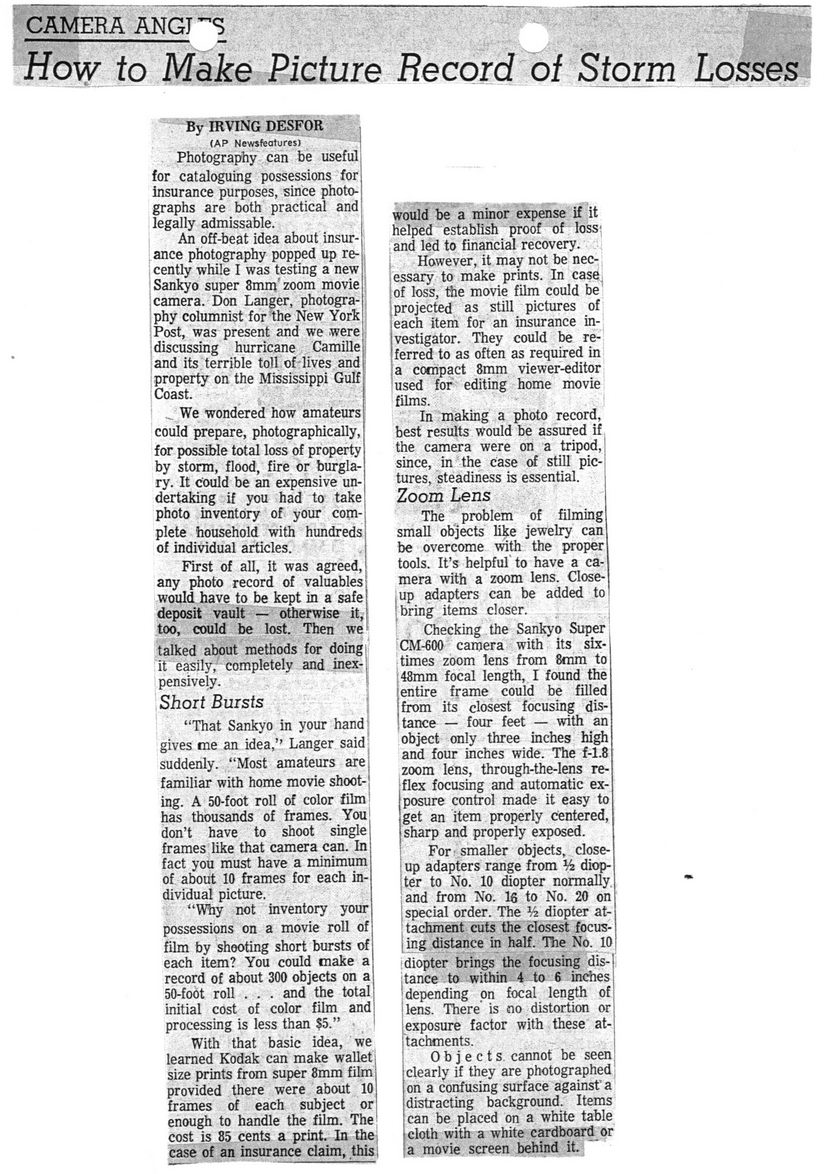This text was obtained via automated optical character recognition.
It has not been edited and may therefore contain several errors.
CAMERA ANGJ "S How to Make Picture Record ot Storm Losses By IRVING DESFOR (AP Newsfeatures) ' ~ Photography can be useful for cataloguing possessions for Insurance purposes, since photographs are both practical and legally admissable. An off-beat idea about insur-: ance photography popped up re- i cently while I was testing a new Sankyo super 8mm' zoom movie camera. Don Langer, photography columnist for the New York Post, was present and we were discussing hurricane Camille and its terrible toll of lives and property on the Mississippi Gulf Coast. . We wondered how amateurs could prepare, photographically, for possible total loss of property by storm, flood, fire or burglary. It could be an expensive undertaking if you had to take photo inventory of your complete household with hundreds of individual articles. First of all, it was agreed, any photo record of valuables would have to be kept in a safe deposit vault — otherwise it,| too, could be lost. Then we* talked about methods for doing: it easily, completely and inex-. pensively. Short Bursts “That Sankyo in your hand gives me an idea,” Langer said suddenly. “Most amateurs are, familiar with home movie shoot-' ing. A 50-foot roll of color film has thousands of frames. You, don’t have to shoot single frames like that camera can. In fact you must have a minimum of about 10 frames for each individual picture. “Why not inventory your possessions on a movie roll of film by shooting short bursts of each item? You could make a record of about 300 objects on a 50-foot roll . . . and the total initial cost of color film and; processing is less than $5.” With that basic idea, we learned Kodak can make wallet size prints from super 8mm film provided there were about 10 frames of each subject or’ enough to handle the film. The cost is 85 cents a print. In the case of an insurance claim, this, would be a minor expense if it helped establish proof of loss; and led to financial recovery. However, it may not be necessary to make prints. In case, of loss, the movie film could be projected as still pictures of each item for an insurance investigator. They could be referred to as often as required in a compact 8mm viewer-editor used for editing home movie films. In making a photo record, best results would be assured if, the camera were on a tripod,1 since, in the case of still pictures, steadiness is essential. Zoom Lens The ^ problem of filming small objects like jewelry can be overcome with the proper tools. It’s helpful to have a camera with a zoom lens. Close-,up adapters can be added to [bring items closer. i Checking the Sankyo Super; CM-600 camera with its six-times zoom lens from 8mm to 48mm focal length, I found the ientire frame could be filled from its closest focusing distance — four feet — with an object only three inches high and four inches wide. The f-1.8 zoom lens, through-the-lens reflex focusing and automatic exposure control made it easy to get an item properly centered sharp and properly exposed. For smaller objects, close-up adapters range from % diopter to No. 10 diopter normally and from No. 16 to No. 20 on I special order. The % diopter attachment cuts the closest focussing distance in half. 'Hie No. 10 ! diopter brings the focusing distance to within 4 to 6 inches 'depending on focal length of | lens. There is no distortion or exposure factor with these attachments. Objects cannot be seen clearly if they are photographed on a confusing surface against’ a distracting background. Items can be placed on a white table cloth with a white cardboard_or a movie screen behind it.

Hurricane Camille Camille-Aftermath-Media (084)